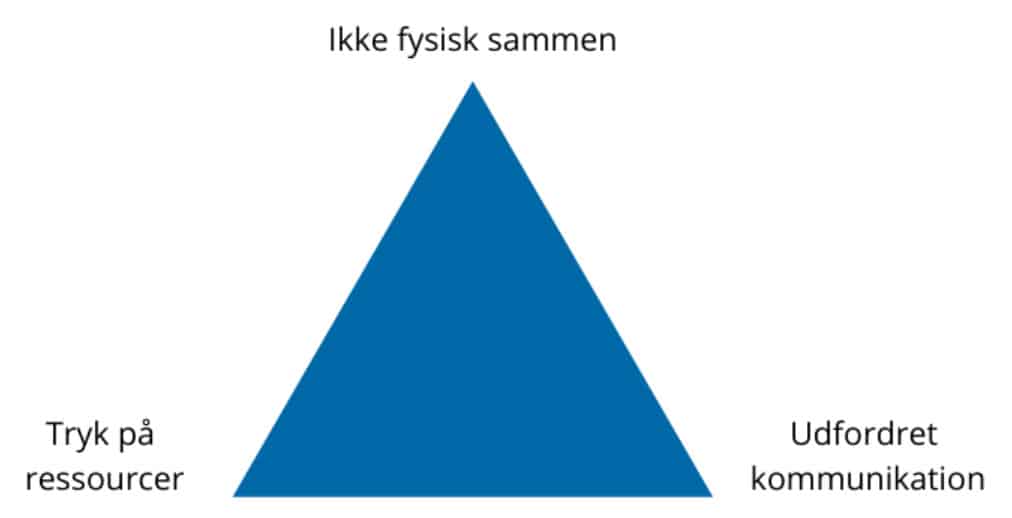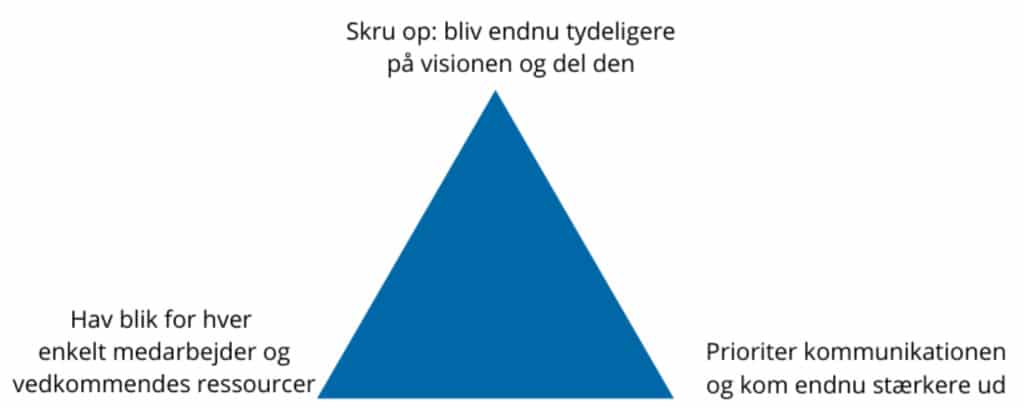Setting a clear direction has never been more important
"... all public leaders must be able to set a meaningful direction through a clear vision for their organization. If you can't and won't do that, you shouldn't be a leader."
- Ledelseskommissionen
Leaders must be able to set a clear and meaningful direction for their organization - especially in times of crisis. But how do leaders do this in practice during the Corona crisis? Find out in this LEAD Talk and in the article here.
What is vision management?
A vision is a picture of a future you want to contribute to. It embodies the "why" of the organization, and what makes it special is that it is desirable - worthy of being desired.
Visionary leadership works if you get off the sidelines. A vision shouldn't gather dust in a leader's office, it should be shared throughout the organization. If you succeed with vision management, your organization performs better. You are more likely to achieve your goals and create value - not just for the individual citizen, the individual child, the individual elderly person in the care center, but also for society as a whole. So the simple reason to emphasize vision management is that it works.
In everyday life, we often see leaders practicing vision management by combining the following three approaches:
- Be clear about what the vision is.
- Share the vision - remember a vision gathering dust in the manager's office does more harm than good.
- Hang in there and continue to concretize, translate and translate the vision together with your employees.
During the Corona crisis, we are often physically separated from our colleagues and there is a higher level of uncertainty than usual. At the same time, many have to make an extraordinary effort. This calls for vision leadership.
How do you do it in practice? The simple answer is to SKRU UP and get even closer to what the vision means in a crisis. In practice, this can be done by following these four steps:
Vision leadership in a time of crisis - 4 steps
1. Provide a guiding star: Share the big picture and set a direction based on the vision:
That's why we're here ...., and in a crisis, that means we make a difference by...
2. Get close to local goals: Ensure clear goal setting and prioritization based on the vision, but with broad involvement:
What is the most important thing to do?
3. Create meaning: Constant focus on motivation and meaning creation:
How, and for whom, do we make a difference in the crisis?
4. Continuously evaluate your efforts and create learning: Take pit stops to reflect on the vision:
Are we making the difference we want to make? Are we doing the right things in everyday life?
(Inspired by Nyvang Qvick and Høstrup, 2019)
JOIN OUR COURSE
Build wellbeing and trust despite the distance
The "Managing Virtual and Hybrid Work Communities" course gives you the essential tools to increase productivity and well-being through remote management.
This is a course for those who work in management and want to know how to achieve strategic goals as an individual or organization through virtual collaboration.
Three special Corona constraints for vision leadership - and what to do about them
The corona crisis presents some unique challenges when it comes to vision management:
- Managers and employees are physically separated. In the current crisis, a lot of time is spent on their own.
- Communication during the Corona crisis is less rich than usual. The connection may stutter, Zoom may drop out or the Skype meeting may have poor audio. We only see part of each other and can't read each other like when we're in the same room.
- The resources to bid on the vision are different than usual. Even though we are professionally alone, we are not always physically alone. For example, some stay at home with children. This means that the conditions for success are completely different than usual. Employees have different resources - some may have extra time, while others are under more pressure than usual.

The manager can handle the three constraints by:
- Step it up: Become even clearer on what your organization's vision is and become even stronger in sharing it. See the four steps we describe later in this article.
- Prioritize communication and come out stronger. Set aside much more time for communication than usual. Use video or other media to reach employees.
- Have an eye for each individual employee. The manager must respect the fact that employees have different conditions and resources and be able to see all employees and recognize them for doing their best - this is important in order not to wear employees out during the crisis.

Pitfalls and what to do when you spot them
In a crisis, it's crucial that you as a leader are able to spot problems - and do something about them. Here's a brief overview of what you need to pay special attention to if, like us, you believe vision leadership is important.
No guiding star:
"I'm not sure what our course is". "We haven't really talked much about what we should contribute during the crisis".
- If you have employees who feel this way, it's important to talk to them. This is where the vision can help create meaning and direction.
Decoupled local goals:
"Everyone has their own agenda". "No one is going to kill my darlings"."We haven't prioritized what's the most important thing to do". "Everyone figures it out for themselves when they have time, but they're busy looking after their kids".
- Engage with employees and set a concrete, shared direction.
- While you as a leader should lead the way, be careful not to dictate the journey in detail.
Loss of meaning:
"We can't really make a difference in the crisis. If I just worked in healthcare, it would be a different matter."
- Together with the employee, get clear on what you contribute in concrete terms. The vision can also help here. It's about setting a meaningful and clear direction.
- Many public employees are driven by Public Service Motivation, which is an individual's orientation towards providing services to people with the aim of doing good for others and society. This is where the public sector really comes into its own. Activate it.
Blind flying:
"We're too busy to reflect on what we're doing", "We've agreed that we'll have a staff meeting just before the summer vacation when it's all over. Then we can talk about how it all went".
- The higher the pressure on the organization, the more important it is to have short iterations where you stop and reflect on questions like: "What have we done, what can we learn from it and how can we move forward?"
If you, as a leader, can set a clear and meaningful direction, you'll be able to motivate and drive results. And in a time of crisis, it's never been more important to lead with a concrete vision.
In short: Clarify the vision, stick to it, and make sure you share it with the people in your organization.




